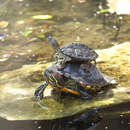pt-BR
nomes no trilho de navegação


The number of turtles in each species of Graptemys has declined in past years. Several factors have been found to contribute to this decline, including environmental changes (pollution, habitat reduction, etc.), predation, and pet trade. Graptemys versa has had no state-regulated conservation program implemented. In 1996, however, a proposal was submitted to the Convention of International Trade of Endangered Species of World Fauna and Flora (U.S. Fish and Wildlife Service) for inclusion of all Graptemys sp. in Appendix II. Several other species in this genus have conservation programs at both the state and national levels (Amendments 1996; Bartlett 1999; Kirkpatrick 1993; Line 1998).
IUCN Red List of Threatened Species: lower risk - near threatened
N/A
This genus as a whole has become extremely important in the pet trade market because of its species' beautiful markings. Graptemys sp. had an exporting price set at $2.52 (U.S currency) in 1993. In that same year, exports from the U.S. totaled $37, 233. Exact figures on Graptemys versa aren't available (Bartlett 1999; Amendments 1996).
This species of turtle has a diet consisting of small mollusks, such as snails, and some local vegetation. In captivity, meats (fish, chicken, beef), dog food, insects, and at times lettuce are the recommended diet. Females, because of their larger head size, tend to be more carnivorous, while males are primarily omnivorous (Bartlett 1999; Ernst 1994; Line 1998).
An endemic species of the state of Texas, Graptemys versa, or what is commonly called the Texas Map Turtle, is found only within the Edwards Plateau region of Central Texas. It makes its home with in the streams and tributaries of the Colorado River drainage area (Bartlett 1999; Ernst 1994; Smith 1952).
Biogeographic Regions: nearctic (Native )
These turtles stay within close proximity of the Colorado River drainage area. They prefer shallow waterways where there is a moderate current and abundant vegetation. The substrates of the waterways these turtles inhabit tend to be either sand, clay, or limestone. When not in the water, they are often found on basking snags (Bartlett 1999; Ernst 1994; Kirkpatrick 1993).
Aquatic Biomes: rivers and streams
Of all the Graptemys species, the Texas Map Turtle is the smallest. This species is sexually dimorphic.Females range in length from 5-8 inches long, while males tend to be about half the length of females, approximately 2.5-4 inches. The carapace of these turtles is an olive color, with intricate yellow-orange lines on each scute. The vertebral keel, which is even more prominent in the immature turtles, has dark yellow shading on the adults. The plastron is cream colored and bears few markings except for the dark lines that outline the seams. Its head is tapered with a pointed snout. Yellow and orange patterns also decorate its head, neck, legs, and tail. These patterns, which resemble the intricate contour lines of a map, give the map turtle its name. Males have long, dense tails, and older females have larger heads than younger females. The most noticeable characteristic of this turtle, though, is the prominent orange, J-shaped mark that sits directly behind each eye. Although there are several turtle species that resemble the Texas Map Turtle, this mark helps to easily distinguish it from other species (Bartlett 1999; Ernst 1994; Kirkpatrick 1993, Smith 1952).
Other Physical Features: ectothermic ; bilateral symmetry
It is believed that these turtles mate in both early spring and late fall. Head bobbing by males has been observed during mating season, although specific mating behaviors have yet to be described. Females come on shore to lay their eggs. They make their nests (usually several inches deep) along sandbars and other sandy areas that provide protection to the clutch. The female usually lays few eggs; six eggs have been the most known laid in any one clutch. The eggs hatch sixty-five to eighty-five days after being deposited. Hatchlings have not been readily observed in their natural habitat. Sex determination in these turtles is temperature dependent. Generally, species within the Graptemys genus produce mostly males at temperatures lower than 28 degrees Celsius and mostly females at temperatures 30 degrees Celsius or above, although specific temperatures for G. versa have not been found. Karyotyping of this species has revealed that these turtles have 50 chromosomes: 12 pairs of microchromosomes, 11 pairs of metacentric, and 2 pairs of acrocentric macrochromosomes. This is a unique characteristic, because not all species within Graptemys share this number or arrangement of chromosomes (Bartlett 1999; Ernst 1994; Line 1998; White 1986).
Key Reproductive Features: gonochoric/gonochoristic/dioecious (sexes separate)